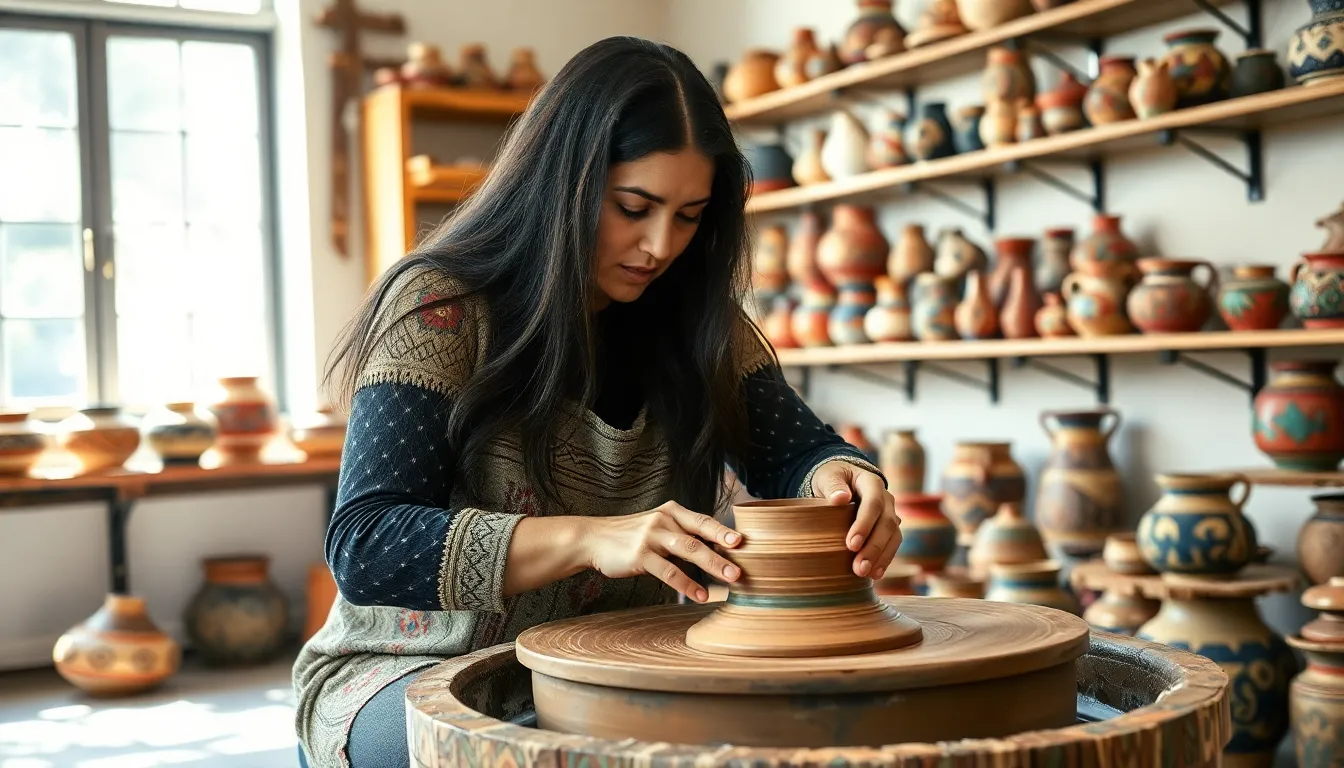Table of Contents
ToggleCrafts aren’t just about glue sticks and glitter; they’re vibrant expressions of cultural identity that weave stories through every stitch and stroke. Imagine a world where each handmade item carries whispers of tradition, history, and community. From intricate pottery to colorful textiles, these creations serve as a bridge connecting generations, showcasing the unique flavors of cultures around the globe.
In a world that often feels homogenized, crafts stand out as a delightful reminder of our rich diversity. They’re not just hobbies; they’re the heartbeat of cultural heritage. So grab your paintbrush or knitting needles, and let’s dive into how these artistic endeavors shape identities and keep traditions alive. After all, who knew that a simple craft could pack such a punch in preserving culture?
Understanding Cultural Identity Through Crafts
Cultural identity encompasses the shared beliefs, values, customs, and practices within a community. It shapes how individuals perceive themselves and their connections to their heritage. Craftsmanship embodies these elements, reflecting the uniqueness of each culture.
The Definition of Cultural Identity
Cultural identity represents an individual’s sense of belonging to a particular group. It derives from aspects such as language, traditions, and shared history. This identity informs personal values and influences social interactions. Individuals express their cultural identity through various means, including storytelling, music, and crafts.
The Role of Crafts in Cultural Expression
Crafts serve as powerful tools for expressing cultural identity. Artisans convey traditions, rituals, and community values through their work. Each piece, from intricately woven textiles to hand-carved sculptures, carries historical significance. Engaging in crafts allows individuals to connect with ancestors and share their heritage with future generations. Craftsmanship not only preserves techniques but fosters cultural pride and diversity.
Historical Context of Crafts

Crafts represent a rich landscape of cultural history. Each form connects individuals to their heritage and ancestral practices.
Traditional Crafts and Their Significance
Traditional crafts serve as vital reflections of cultural identity. Techniques and designs often pass down through generations, embodying unique stories. For example, indigenous pottery may showcase local materials and spiritual beliefs. In many cultures, artisans use traditional skills to create functional items and celebrate significant rituals. Engaging with these crafts fosters pride and strengthens community ties. Preservation of these practices ensures they remain integral to cultural narratives.
Evolution of Craft Practices Over Time
Craft practices evolve while maintaining historical foundations. Changes often arise in response to technological advancements and globalization. For instance, the introduction of synthetic materials has transformed textile production. Yet, many artisans continue to prioritize traditional methods as a form of resistance. By adapting to modern influences, crafts retain relevance while honoring past techniques. Current trends may blend traditional artistry with contemporary design, creating new expressions of identity. Such evolution highlights resilience in culture and the enduring importance of crafts.
The Connection Between Crafts and Cultural Identity
Crafts play a vital role in expressing cultural identity, intertwining creativity with tradition. Every handcrafted item reflects unique histories and communal values.
Symbolism in Craftsmanship
Symbolism thrives in craftsmanship, where each design element conveys cultural narratives. Patterns and colors often hold specific meanings, connecting artisans to their heritage. Pottery in Mexico may feature designs representing local flora, while textiles in Africa often showcase stories of community life. These symbols bridge past and present, allowing artisans to articulate identities through their crafts. Each crafted piece becomes a vessel of cultural history, affirming the distinctiveness of various cultures.
Case Studies of Indigenous Crafts
Indigenous crafts offer compelling insights into the resilience of cultural identity. Native American beadwork highlights spiritual beliefs and tribal affiliations, showcasing intricate designs that tell ancestral tales. Similarly, the Inuit’s carving of bone and stone reflects their relationship with the Arctic environment, preserving survival skills and traditions. These crafts serve not just aesthetic purposes but also act as vital links to identity and legacy. Through the lens of these unique cases, one can appreciate the depth of cultural significance embedded in indigenous craftsmanship.
Modern Perspectives on Crafts and Identity
Crafts engage with cultural identity, reflecting contemporary understandings and interpretations.
Contemporary Artists and Cultural Representation
Today’s artists often blend traditional techniques with modern aesthetics. These creators amplify cultural narratives by integrating personal stories into their works. They challenge stereotypes and expand representations of their communities. This approach not only celebrates diversity but also encourages dialogue around identity. For instance, contemporary Indigenous artists use traditional motifs to address modern issues, infusing their heritage into relevant conversations. Each piece they produce generates connections between past and present, underlining the ongoing relevance of cultural expression.
The Impact of Globalization on Local Crafts
Globalization shifts the landscape of local crafts, promoting both challenges and opportunities. Artisan communities face competition from mass-produced goods, threatening traditional craftsmanship. Despite this challenge, many artisans adapt by innovating and maintaining their distinctive aesthetic. Some blend traditional methods with contemporary design, creating unique marketable products. This fusion allows them to reach global audiences while preserving cultural authenticity. Rising interest in sustainable practices further enhances the appeal of handmade items, emphasizing their cultural significance in an increasingly commercial world.
Crafts serve as a vital link to cultural identity, weaving together stories of heritage and community. Each handmade piece not only reflects individual artistry but also embodies the collective spirit of a culture. As artisans continue to adapt and innovate, they ensure that traditions remain relevant in a changing world. This dynamic interplay between the past and present highlights the importance of craftsmanship in fostering cultural pride and resilience. Engaging with these art forms invites everyone to appreciate the rich tapestry of human experience, reminding us of the shared narratives that shape our identities. Through crafts, individuals can celebrate their heritage while contributing to a diverse cultural landscape.








